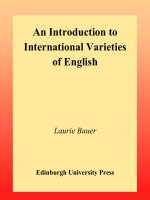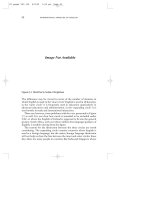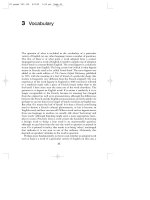Các biến thể của tiếng anh part 1 pptx
Bạn đang xem bản rút gọn của tài liệu. Xem và tải ngay bản đầy đủ của tài liệu tại đây (180.69 KB, 10 trang )
An Introduction to
International Varieties
of English
Edinburgh University Press
Laurie Bauer
An Introduction to
International Varieties
of English
Laurie Bauer
Edinburgh University Press
01 pages i-viii prelims 6/8/02 1:25 pm Page i
© Laurie Bauer, 2002
Edinburgh University Press Ltd
22 George Square, Edinburgh
Typeset in Janson
by Norman Tilley Graphics and
printed and bound in Great Britain
by MPG Books Ltd, Bodmin, Cornwall
A CIP record for this book is available from the British Library
ISBN 0 7486 1337 4 (hardback)
ISBN 0 7486 1338 2 (paperback)
The right of Laurie Bauer
to be identified as author of this work
has been asserted in accordance with
the Copyright, Designs and Patents Act 1988.
01 pages i-viii prelims 6/8/02 1:25 pm Page ii
Disclaimer:
Some images in the original version of this book are not
available for inclusion in the eBook.
Contents
Acknowledgements v
Abbreviations and conventions used in the text vi
To readers vii
1 Background notions 1
1.1 Accent, dialect, language and variety 2
1.2 Home and colony 4
1.3 Colonial lag 5
1.4 Dialect mixing 6
Exercises 11
Recommendations for reading 12
2 English becomes a world language 13
2.1 The spread of English 13
2.2 Models of English 19
2.3 English in Scotland and Ireland 25
Exercises 28
Recommendations for reading 29
3 Vocabulary 32
3.1 Borrowing 33
3.2 Coining 40
3.3 The results 42
Exercises 44
Recommendations for reading 45
4 Grammar 46
4.1 Morphology 46
4.2 Syntax 48
4.3 Discussion 58
Exercises 59
Recommendations for reading 60
01 pages i-viii prelims 6/8/02 1:25 pm Page iii
5 Spelling 61
5.1 Lexical distributional differences 62
5.2 Variation in the system 62
5.3 Conclusion 66
Exercises 67
Recommendations for reading 68
6 Pronunciation 69
6.1 Describing varieties of English 69
6.2 Input varieties 71
6.3 Influences from contact languages 73
6.4 Influences from other colonies 74
6.5 Influences from later immigrants 75
6.6 Influences from world English 75
6.7 Differences between varieties 76
Exercises 82
Recommendations for reading 83
7 The revenge of the colonised 84
7.1 Vocabulary 86
7.2 Grammar 86
7.3 Pronunciation 88
7.4 Conclusion 90
Exercises 91
Recommendations for reading 92
8 Becoming independent 93
8.1 British Englishes 95
8.2 North American Englishes 97
8.3 Southern hemisphere Englishes 98
8.4 Discussion 99
8.5 The break-up of English? 100
Exercises 102
Recommendations for reading 103
9 Standards in the colonies 104
9.1 Moving away from the standard in vocabulary 104
9.2 Moving away from the standard in grammar 105
9.3 Moving away from the standard in pronunciation 108
9.4 Discussion 110
Exercises 112
Recommendations for reading 112
Discussion of the exercises 113
References 127
Index 133
iv INTERNATIONAL VARIETIES OF ENGLISH
01 pages i-viii prelims 6/8/02 1:25 pm Page iv
Acknowledgements
Grateful acknowledgement is made to the following sources for
permission to reproduce material in this book previously published
elsewhere. Every effort has been made to trace copyright holders, but
if any have been inadvertently overlooked the publisher will be pleased
to make the necessary arrangement at the first opportunity.
Cambridge University Press and Tom McArthur for Figure 2.4 on p. 22,
from McArthur (1987).
Contact, for the text published on 27 February 1992 reproduced on p. 103.
Max Niemeyer Verlag GmbH for Figure 2.3 on p. 21, from Görlach
(1990a).
The New Zealand Listener, for the letter to the editor of 12 March 1983
reproduced on p. 102.
Professor D. Throsby for the text from The Sydney Morning Herald of
9 August 1999 reproduced on p. 67.
Times Newspapers Limited for Eleanor Mills’s Column, The Sunday
Times, 7 January 2001. © Times Newspapers Limited 2001, reproduced
on p. 90.
The author would like to thank Carolin Biewer for searching corpora
for data for Chapter 5, and the following people who have commented
on earlier drafts: Winifred Bauer, Derek Britton, Jack Chambers, Vivian
de Klerk, Manfred Görlach, Edgar Schneider. None of them is respon-
sible for any errors of fact or interpretation.
v
01 pages i-viii prelims 6/8/02 1:25 pm Page v
Abbreviations and conventions
used in the text
/…/ enclose a phonemic transcription
[…] enclose a phonetic transcription, where the actual sounds made
are the focus of attention
<…> enclose an orthographic representation; enclose URLs
small capitals indicate lexical sets, see section 6.1
* not a grammatical sentence/construction
Aus Australia(n)
CDN Canada/Canadian
GA General American, see section 6.1
NAm North American
NZ New Zealand
RP Received Pronunciation, see section 1.1
SA South Africa(n)
Transcription systems for RP and GA are those used in the companion
volume, McMahon (2002).
vi
01 pages i-viii prelims 6/8/02 1:25 pm Page vi
To readers
The title of this book, International Varieties of English, requires some
comment. It might be expected that this would refer to varieties of
English which are used internationally, but this is not its normal field of
use. Instead, it is a well-established label for varieties of English which
are used nationally in different places in the world. Although ‘national
varieties of English’ might be a more transparent term, this widely
accepted though slightly peculiar use of ‘international varieties’ is main-
tained in this book.
While most books on international varieties of English take each
variety in turn and discuss the vocabulary, grammar and pronunciation
which is special to that variety, this book aims to seek out generalities
which determine the ways in which English will diverge in different
locations. Accordingly, there are chapters dealing with matters such as
vocabulary, grammar and pronunciation, but in each it is shown how the
same fundamental principles apply to a number of different varieties
with disparate outcomes. So the question is not How do they speak English
in X? where ‘X’ is some Anglophone country, but rather Why have the
varieties of English round the world turned out the way they have? Corres-
pondingly, the exercises are designed to make students think about what
it means to speak Australian or Falkland Islands English, what the his-
torical influences on any given variety are, and how familiar notions such
as ‘standard’ apply outside Britain or the USA.
I hope that this book will complement and be complemented by
books which take a more traditional approach, and that this volume will
be useful for courses which aim to consider the English language as used
in a particular area or country as well as for courses which are intended
to explore the linguistic principles underlying linguistic colonisation
and globalisation.
Teachers and students alike are encouraged to go beyond the book
by studying texts from various countries round the world, listening to
speakers from these countries, and talking to them if at all possible. That,
after all, is the best way to get a feel for how different the international
Englishes can be, and how much they have in common.
vii
01 pages i-viii prelims 6/8/02 1:25 pm Page vii
Edinburgh Textbooks on the English Language
General Editor
Heinz Giegerich, Professor of English Linguistics (University of Edinburgh)
Editorial Board
Laurie Bauer (University of Wellington)
Derek Britton (University of Edinburgh)
Olga Fischer (University of Amsterdam)
Norman Macleod (University of Edinburgh)
Donka Minkova (UCLA)
Katie Wales (University of Leeds)
Anthony Warner (University of York)
An Introduction to English Syntax
Jim Miller
An Introduction to English Phonology
April McMahon
An Introduction to English Morphology
Andrew Carstairs-McCarthy
An Introduction to Middle English
Simon Horobin and Jeremy Smith
An Introduction to Old English
Richard Hogg
viii
01 pages i-viii prelims 6/8/02 1:25 pm Page viii
1 Background notions
Th
is book
is about the characteristics of the English language as it is
used in various countries around the world. It is restricted, however,
to those varieties of English spoken predominantly by native speakers
of English. This means we will consider the kinds of English spoken in
Britain, the USA, Canada, South Africa, Australia, New Zealand and the
Falkland Islands, but will have little to say about the varieties spoken
in Nigeria, Jamaica, Singapore, Hong Kong or the Philippines. This
distinction will be spelt out in greater detail and justified further in
section 2.2 and immediately below. Here I merely draw attention to this
self-imposed limitation, and make the point that this book does not
attempt to provide in-depth coverage of English in all the countries in
which it has a significant place.
To some extent, this limitation is a consequence of the introductory
nature of this text. The cases dealt with here are all the easy ones: they
arise by putting speakers of different varieties of English together and
letting a new variety emerge, influenced by surrounding languages
in ways which will be explored in this book. These relatively simple
processes also apply in more complex situations, but other factors also
play important roles there. To deal with the situation in Nigeria or
Singapore, we would need some understanding of the contact situation
in which the varieties of English there developed, including the political
and educational conditions. In particular we would need to know about
the principles affecting languages in contact, especially where the
language we are interested in remains a minority one for a long period.
We would also have to know a lot more about the languages spoken
in these areas at the time English was introduced – in both these cases,
this means several languages. If we wanted to look at pidgin and creole
languages such as Tok Pisin in Papua New Guinea or Krio in Sierra
Leone we would need to know about the general principles which
govern the process of simplification (producing pidgins) and the prin-
ciples of reconstructing grammatical complexity (producing creoles).
These are interesting issues, but not elementary ones.
1
02 pages 001-136 6/8/02 1:26 pm Page 1









